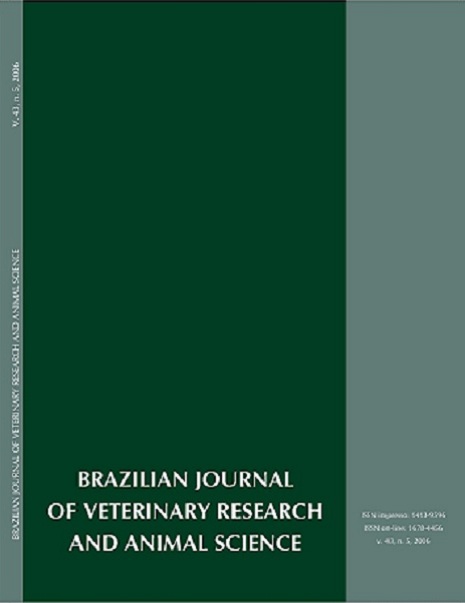Bovine septic podermatitis: clinial evolution of the early stage
DOI:
https://doi.org/10.11606/issn.1678-4456.bjvras.2006.26577Keywords:
Bovine, Digital diseases, Clinical evolution, Septic dermatitisAbstract
This study aimed to describe the clinical signs of the initial phase of septic pododermatitis in thirty female girolando bovines under the same handling care from different farms in State of Goiás. Following the diagnosis, they were submitted to daily clinical examination of the hoofs during fifteen days. It was considered as the end of the initial phase the presence of fistula in interdigital space or when the observation time over. It was observed the farm's soil type and the period of the year (if rainy and dryness). During the disease evolution, edema and pain increased in progressive order until skin disruption and fistula formation. In 73,33%, the illness envolved the hind limbs. In 50,00% it was observed moderate edema and 26,67% intense edema in both limbs. Fistula occurred in 83,33% ill animals until sixth day, in 10% between seventh and eleventh days and in 6,67% of the cases it was't observed. Fistulation areas were middle point of interdigital space in 63,33%; dorsal region of interdigital space in 16,67% and in coronary corium of the abaxial region of the hoof in 10,00% and in palmar/plantar region between coronary cushion in 3,33% of cases. The septic pododermatitis showed the same clinical signs in farms considered in this study and in different periods of the year, differing in time and fistula site. The average time from diagnosis and fistulation was five days. The more commom site was the middle point of the interdigital space.Downloads
Download data is not yet available.
Downloads
Published
2006-10-01
Issue
Section
UNDEFINIED
License
The journal content is authorized under the Creative Commons BY-NC-SA license (summary of the license: https://
How to Cite
1.
Silva LAF da, Rosana Rezende M, Romani AF, Fioravanti MCS, Cunha PHJ da, Borges JRJ, et al. Bovine septic podermatitis: clinial evolution of the early stage. Braz. J. Vet. Res. Anim. Sci. [Internet]. 2006 Oct. 1 [cited 2024 Apr. 16];43(5):674-80. Available from: https://revistas.usp.br/bjvras/article/view/26577





